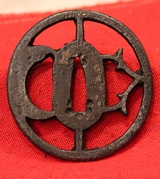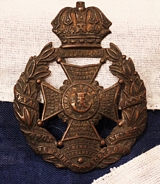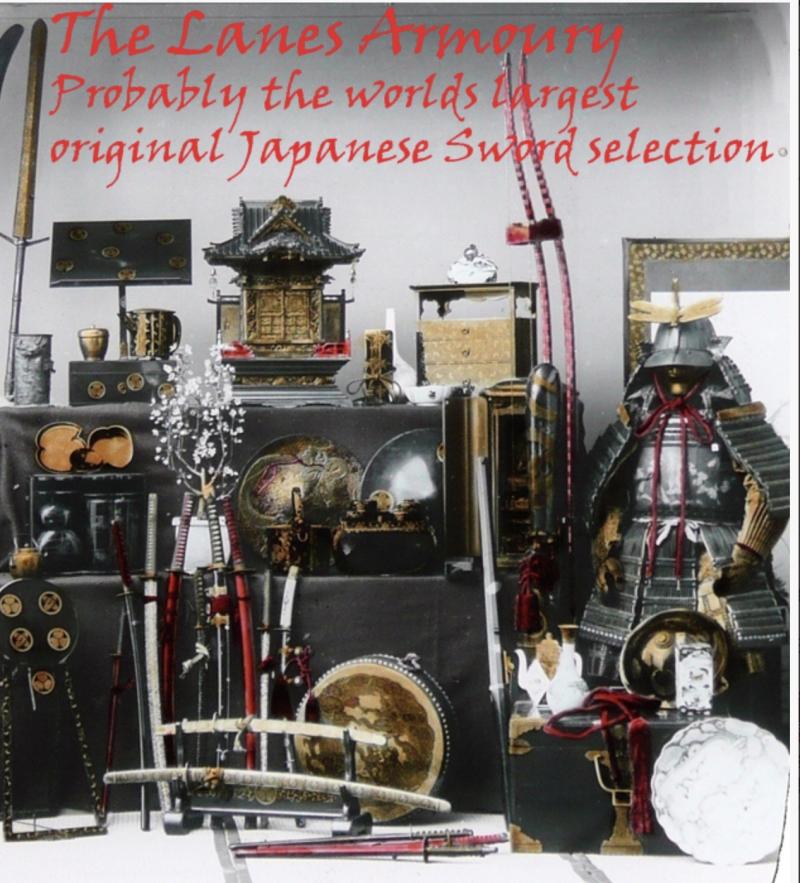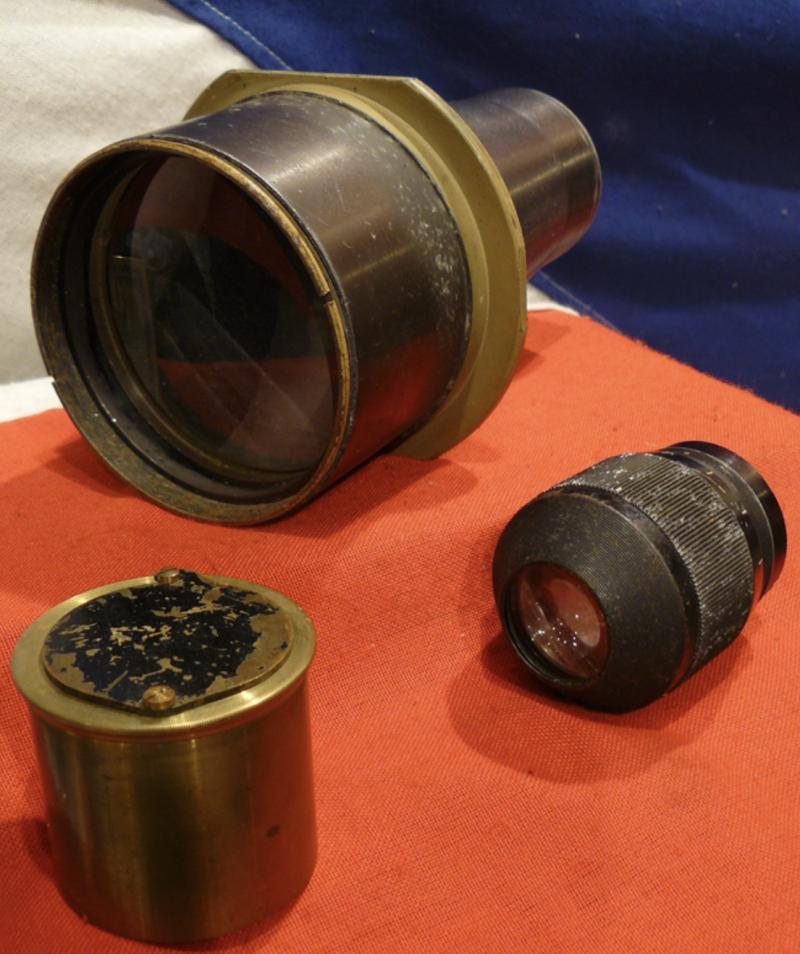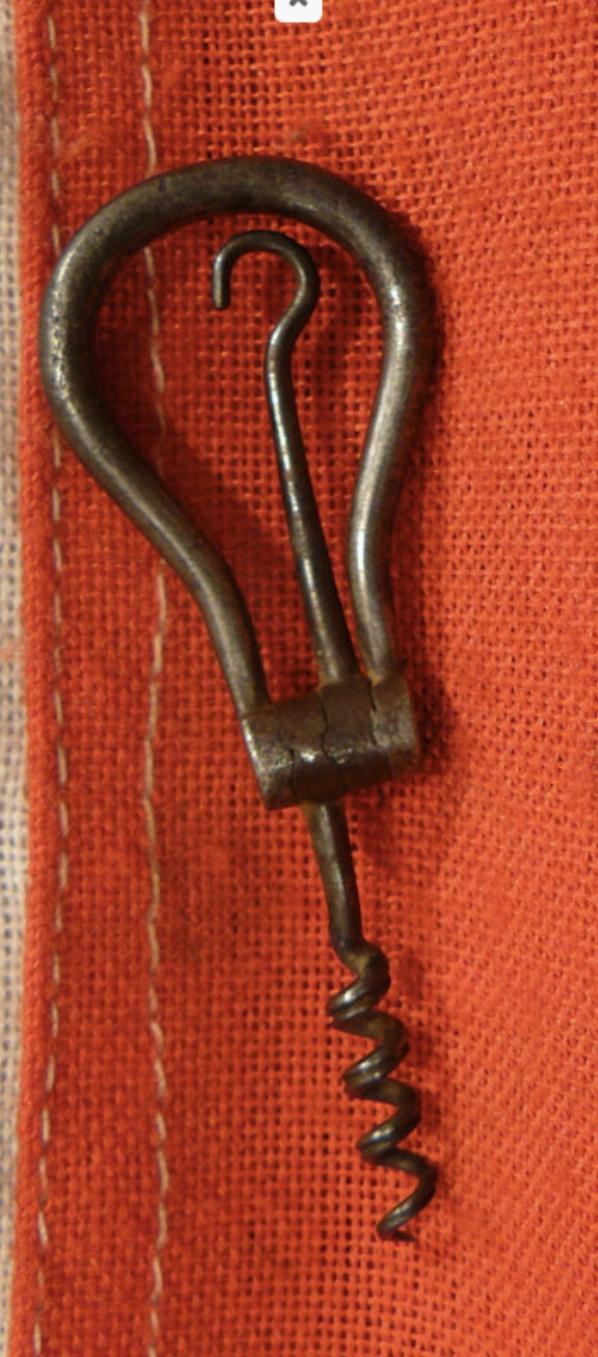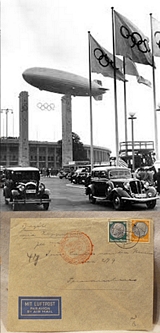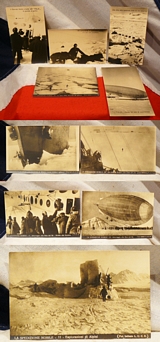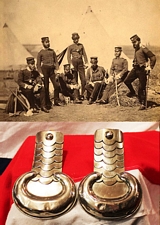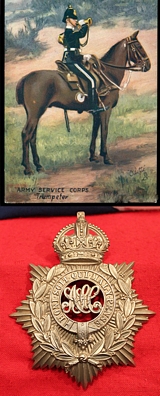An Edo O Sukashi Wakazashi or Tanto Tsuba In Iron
Circa 1650. The Tsuba, or Japanese sword guard, is a refined utilitarian object. It is essentially a sheath for the blade to fit through, protecting the hand of the warrior. The Tsuba can be solid, semi pierced of fully pierced, with an overall perforated design, but it always a central opening which narrows at its peak for the blade to fit within. It often can have openings for the kozuka and kogai to pass through, and these openings can also also often be filled with metal to seal them closed. For the Samurai, it also functioned as an article of distinction, as his sole personal ornament. read more
265.00 GBP
Rifle Brigade Victorian OR’s Helmet Plate
An excellent example, die-stamped blackened on two loops. Within a laurel wreath surmounted by a Guelphic Crown resting on a tablet inscribed Waterloo, a Maltese cross with lions between the arms and ball finials to the tips. The arms of the cross bear numerous honours; the wreath bears honours Sevastopol Alma Inkerman. Between the bottom arm of the cross and the wreath, three scrolls Lucknow over Peninsula with Ashantee below; across the base of the wreath, a scroll The Prince Consort’s Own’
9.5cm high read more
175.00 GBP
The Lanes Armoury & The Hawkins Family Established For Over 100 Years
In fact the family has been trading in Brighton for likely 200 years, but the first 100 Years was in the local fish and shellfish trade, becoming shopkeepers in antiques in the town in the last 100 years. Apparently the family moved from our seafaring roots in Plymouth, around 200 years ago, where we had been trading since the 1500’s, and during reign of The Tudors, Admiral Sir Francis Drake had been an adopted apprentice from the age of 15 of the Hawkins family in Plymouth..
The current partners, Mark and David have between them almost 95 years combined service to the company, serving the public and trade in ‘The Lanes’ of Brighton. In fact, we believe, out of approximately 2000 shops, and goodness knows how many businesses in the city, we are now the oldest, remaining, established family traders within the whole of Brighton and Hove.
BRIGHTON and Hove has been named the second-best area for independent shopping in the United Kingdom, only just pipped at the post by Cambridge. If you are going to be beaten by a town at least it was Cambridge [apologies to Oxford, but you ought to be used to it by now]
Taken from the Brighton and Hove.gov website; ‘The Lanes’ is listed first of the four main shopping areas; ‘ The Lanes - historic maze of alleyways with a mix of antiques, jewellery and fashion’
But sadly, we are the only antique and bookshop now still remaining in ‘The Lanes’ read more
Price
on
Request
A Rare Set of Spare Parts For A German WW2 Panzer Binocular Gun Sight
With excellent lenses.
Ideal for the collector of WW2 German military opticals, perfect as spares or for replacing lost or damaged parts. They would cost many, many times the price we ask to re manufacture, if they could even be replicated today, and may not be needed now, but to save them in case of need one day, would be exceptionally prudent and sound logic.
They could also be perfect for a collector of German WW2 Panzer military equipment at relatively minute cost.
Photo 3 in the gallery shows a complete binocular with the parts we offer in place
The beauty of these parts is that they are universal fit, even though they came from a panzer case originally they would fit kriegsmarine gun sights and luftwaffe anti aircraft sights read more
175.00 GBP
A Wonderful Georgian ‘Grand Tour’ or Campaign Travelling Miniature Foldaway Corkscrew and Hook
In delightfully blued steel and only 3.25cm long when folded. Made to be used with very small, corked, glass bottles containing everything from gun oil, for gun cases, to writing ink, poisons or colognes. And as a button hook for shoes, riding boots or gaiters. It could be contained in a travelling officer and gentleman’s gun case, campaign toilette case, sabretache or even waistcoat pocket. It would make a delightful additional accessory for a cased set of duellers, a single pistol or hunting guns. Circa early 1800’s read more
125.00 GBP
A Zeppelin Airship Post Letter, For Flight Returning to Berlin for The 1936 Olympics, on the Brazil to Germany Flight, 27 July 1936
A South American Europe Flight, the Hindenberg’s 31st flight, arrived back from Rio to Frankfurt flight and flew to arrive above Berlin at the Olympic Stadium on the 1st August the Olympics of 1936. Superb condition envelope and franked stamps.
The Hindenburg Zeppelin flew over the Olympic Arena, on the 1st of August, and the envelope was date stamped just a few days before on the 27th, midway on its journey from Brazil back to Germany, returning in order to fly at the Olympic Games opening ceremony.
The Berlin Games are best remembered for Adolf Hitler’s failed attempt to use them to prove his theories of Aryan racial superiority. As it turned out, the most popular hero of the Games was the African-American sprinter and long jumper Jesse Owens, who won four gold medals in the 100m, 200m, 4x100m relay and long jump.
Television Coverage
The 1936 Games were the first to be broadcast on television. Twenty-five television viewing rooms were set up in the Greater Berlin area, allowing the locals to follow the Games free of charge.
Young Olympians
Thirteen-year-old Marjorie Gestring of the U.S. won the gold medal in springboard diving. She remains the youngest female gold medallist in the history of the Summer Olympic Games. Twelve-year-old Inge Sorensen of Denmark earned a bronze medal in the 200m breaststroke, making her the youngest medallist ever in an individual event.
Debuts and Firsts
Basketball, canoeing and field handball all made their first appearances
The Hindenburg made 17 round trips across the Atlantic in 1936, its first and only full year of service, with ten trips to the United States and seven to Brazil. In July 1936 it completed a record Atlantic double crossing in five days, 19 hours and 51 minutes. Among the famous passengers was German heavyweight boxing champion Max Schmeling, who returned home on the Hindenburg to a hero's welcome after knocking out Joe Louis in New York on June 19, 1936. During the 1936 season the airship flew 191,583 miles (308,323 km), carried 2,798 passengers, and transported 160 tons of freight and mail, a level of success that encouraged the Luftschiffbau Zeppelin Company to plan the expansion of its airship fleet and transatlantic service.
The airship was reportedly so stable that a pen or pencil could be stood on a table without falling. Its launches were so smooth that passengers often missed them, believing that the airship was still docked to its mooring mast. The cost of one way passage between Germany and the United States was US$400, an especially considerable sum in the Depression era. Hindenburg passengers were generally affluent, including many public figures, entertainers, noted sportsmen, political figures, and leaders of industry.
The Hindenburg was used again for propaganda purposes when it flew over the Olympic Stadium in Berlin on August 1 during the opening ceremonies of the 1936 Summer Olympic Games. Shortly before the arrival of Adolf Hitler to declare the Games open, the airship crossed low over the packed stadium while trailing the Olympic flag on a long weighted line suspended from its gondola.
During 1936 the Hindenburg had a special Bl?thner aluminium grand piano placed on board in the music salon, although the instrument was removed after the first year to save weight. Over the winter of 1936?37, several alterations were made to the airship's structures. The greater lift capacity allowed ten passenger cabins to be added, nine with two beds and one with four beds, thus increasing the total passenger capacity to 72. In addition, "gutters" were installed to collect rain for use as water ballast: taking on rainwater ballast to compensate for the weight of fuel consumed during a voyage was more economical than venting hydrogen.
Another change was the installation of an experimental aircraft hook-on trapeze based on the system similar to the one used on the U.S. Navy Goodyear-Zeppelin built airships Akron and Macon. This was intended to allow customs officials to be flown out to the Hindenburg to process passengers before landing and to retrieve mail from the ship for early delivery. Experimental hook-ons and takeoffs were attempted on March 11 and April 27, 1937, but were not very successful, owing to turbulence around the area where the hook-up trapeze had been mounted. The loss of the ship ended all prospects of further testing. read more
375.00 GBP
A Most Rare Set Of 12 Original Photographs Of The General Nobile 1928 Polar Airship Expedition
Original Polar Expeditions collectables are most highly desirable and we have been delighted to acquire two such connected lots. These are 12 original photographic postcards, published at the time, by two publishers, Traldi and Ballerini & Fratini. For example one is entitled "La Spedizione Nobile - 11 - Esplorazioni di Alpini."
Ed. A. Traldi, Milan, n.d. c. 1928. and another "General Nobile to edge of Italy before leaving."
Umberto Nobile January 21, 1885 ? July 30, 1978) was an Italian aeronautical engineer and Arctic explorer. Nobile was a developer and promoter of semi-rigid airships during the Golden Age of Aviation between the two World Wars. He is primarily remembered for designing and piloting the airship Norge, which may have been the first aircraft to reach the North Pole, and which was indisputably the first to fly across the polar ice cap from Europe to America. Nobile also designed and flew the Italia, a second polar airship; this second expedition ended in a deadly crash and provoked an international rescue effort.The N-class airship Italia was slowly completed and equipped for Polar flight during 1927-28. Part of the difficulty was in raising private funding to cover the costs of the expedition, which finally was financed by the city of Milan; the Italian government limited its direct participation to providing the airship and sending the aging steamer Citt? di Milano as a support vessel to Svalbard, under the command of Giuseppe Romagna.
This time the airship used a German hangar at Stolp en route to Svalbard and the mast at Vads? (Northern Norway). On May 23, 1928, after an outstanding 69 hour long flight to the Siberian group of Arctic islands, the Italia commenced its flight to the North Pole with Nobile as both pilot and expedition leader. On May 24, the ship reached the Pole and had already turned back toward Svalbard when it ran into a storm. On May 25, the Italia crashed onto the pack ice less than 30 kilometres north of Nordaustlandet (Eastern part of Svalbard). Of the 16 men in the crew, ten were thrown onto the ice as the gondola was smashed; the remaining six crewmen were trapped in the buoyant superstructure as it ascended skyward due to loss of the gondola; the fate of the six men was never resolved. One of the ten men on the ice, Pomella, died from the impact; Nobile suffered a broken arm, broken leg, broken rib and head injury; Cecioni suffered two badly broken legs; Malmgren suffered a severe shoulder injury and suspected injury to a kidney; and Zappi had several broken ribs.
The crew managed to salvage several items from the crashed airship gondola, including a radio transceiver, a tent which they later painted red for maximum visibility, and, critically, packages of food and survival equipment which quick-witted engineer Ettore Arduino had managed to throw onto the ice before he and his five companions were carried off to their deaths by the wrecked but still airborne airship envelope and keel. As the days passed, the drifting sea ice took the survivors towards Foyn and Broch islands.
A few days after the crash the Swedish meteorologist Malmgren and Nobile's second and third in command Mariano and Zappi decided to leave the immobile group and march towards land. Malmgren, who was injured, weakened and reportedly still depressed over his meteorological advice that he felt contributed to the crash, asked his two Italian companions to continue without him. These two were picked up several weeks later by the Soviet icebreaker "Krasin". However there were persistent rumors that Malmgren was killed and cannibalized by Zappi and Mariano
They would look incredible suitably bespoke framed [with UV protected glass] read more
675.00 GBP
Greek War Medal 1940-41, Greek Italian War, Battle of Crete
Awarded to Greek and Allied forces that fought agianst the Germans in Crete Battle of Crete 1941 and in Albania, Macedonia, Thrace and Epirus against the Italians.
The Battle of Crete (German: Luftlandeschlacht um Kreta, also Unternehmen Merkur, "Operation Mercury", Greek: Μάχη της Κρήτης) was fought during the Second World War on the Greek island of Crete. It began on the morning of 20 May 1941, when Nazi Germany began an airborne invasion of Crete. Greek and other Allied forces, along with Cretan civilians, defended the island. After only one day of fighting, the Germans had suffered heavy casualties and the Allied troops were confident that they would defeat the invasion. The next day, through communication failures, Allied tactical hesitation, and German offensive operations, Maleme Airfield in western Crete fell, enabling the Germans to land reinforcements and overwhelm the defensive positions on the north of the island. Allied forces withdrew to the south coast. More than half were evacuated by the British Royal Navy and the remainder surrendered or joined the Cretan resistance. The defence of Crete evolved into a costly naval engagement; by the end of the campaign the Royal Navy's eastern Mediterranean strength had been reduced to only two battleships and three cruisers.
The Battle of Crete was the first occasion where Fallschirmjäger (German paratroops) were used en masse, the first mainly airborne invasion in military history, the first time the Allies made significant use of intelligence from decrypted German messages from the Enigma machine,and the first time German troops encountered mass resistance from a civilian population. Due to the number of casualties and the belief that airborne forces no longer had the advantage of surprise, Adolf Hitler became reluctant to authorise further large airborne operations, preferring instead to employ paratroopers as ground troops. In contrast, the Allies were impressed by the potential of paratroopers and started to form airborne-assault and airfield-defence regiments. read more
A Very Good Pair of Early Victorian Crimean War, British Dragoon Tunic Shoulder Scales
Epaulette is a type of ornamental shoulder piece or decoration used as insignia of rank by armed forces and other organizations. Epaulettes bear some resemblance to the shoulder pteruges of ancient Roman military costumes. However their direct origin lies in the bunches of ribbons worn on the shoulders of military coats at the end of the 17th century, which were partially decorative and partially intended to prevent shoulder belts from slipping. These ribbons were tied into a knot which left the fringed end free. This established the basic design of the epaulette as it evolved through the 18th and 19th centuries.
From the 18th century on, epaulettes were used in the French, British and other armies to indicate rank. The rank of an officer could be determined by whether an epaulette was worn on the left shoulder, the right shoulder or on both. Later a "counter-epaulette" (with no fringe) was worn on the opposite shoulder of those who wore only a single epaulette. Epaulettes were made in silver or gold for officers, and in cloth of various colours for the enlisted men of various arms. By the early eighteenth century, epaulettes became the distinguishing feature of an officer, leading to officers of military units without epaulettes to petition their government for the right to wear epaulettes, to ensure that they would be recognized as officers. Certain cavalry specialties wore flexible metal epaulettes referred to as shoulder scales such as these. During the Napoleonic Wars and subsequently through the 19th century, grenadiers, light infantry, voltigeurs and other specialist categories of infantry in many European armies wore cloth epaulettes with wool fringes in various colours to distinguish them from ordinary line infantry. "Flying artillery" wore "wings", similar to an epaulette but with only a bit of fringe on the outside, which matched the shoulder seam. Heavy artillery wore small balls representing ammunition on their shoulders. read more
345.00 GBP
A Scarce Pattern, Edwardian Army Service Corps Helmet Plate
This is not the standard type used from 1902 as they are gilt and have an upright capitalised type font. The Canadian version is very similar but with the word Canada below within asmall scroll, and again, gilt, whereas this example is white metal. Two lugs remaining. The officers and men of the ASC ? sometimes referred to in a joking way as Ally Sloper?s Cavalry ? were the unsung heroes of the British Army in the Great War. Soldiers can not fight without food, equipment and ammunition. They can not move without horses or vehicles. It was the ASC?s job to provide them. In the Great War, the vast majority of the supply, maintaining a vast army on many fronts, was supplied from Britain. Using horsed and motor vehicles, railways and waterways, the ASC performed prodigious feats of logistics and were one of the great strengths of organisation by which the war was won. The largest element of the ASC was the Horse Transport section.
Most Horse Transport Companies were under orders of Divisions, with four normally being grouped into a Divisional Train. Others were part of the Lines of Communication where they were variously known by subtitles as Auxiliary Supply Companies or Reserve Parks.
Soldiers who served in the Horse Transport usually had the letter T as a prefix to their number. The British Army was already the most mechanised in the world when the Great War began, in terms of use of mechanical transport. It maintained that leadership, and by 1918 this was a strategically important factor in being able to maintain supply as the armies made considerable advances over difficult ground.
All Mechanical Transport Companies were part of the Lines of Communication and were not under orders of a Division, although some (unusually known as Divisional Supply Columns and Divisional Ammunition Parks) were in effect attached to a given Division and worked closely with it. Those in the Lines of Communication operated in wide variety of roles, such as being attached to the heavy artillery as Ammunition Columns or Parks, being Omnibus Companies, Motor Ambulance Convoys, or Bridging and Pontoon units.
Soldiers who served in the Mechanical Transport usually had the letter M as a prefix to their number. read more
195.00 GBP


